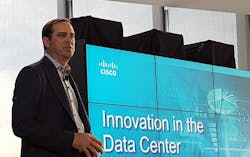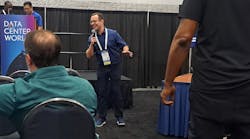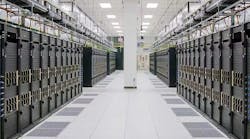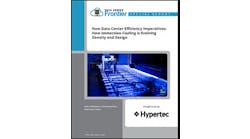NEW YORK – Cisco has entered the data center monitoring market with Tetration, a solution that combines hardware, software, analytics and machine learning. The new offering seeks to provide greater visibility into what’s happening inside the data center, with monitoring and security features to help enterprises, governments and service providers get their arms around the challenges inside their networks.
Cisco clearly sees an opportunity in the crowded market for data center management tools, including tools offered by hardware vendors, software companies and service providers. The problems targeted by Tetration are not new ones, CEO Chuck Robbins said Cisco can bring something new to the table.
“There are products in the marketplace that do pieces of this, or have ambitions to do this,” said Robbins, who spoke at a press event atop One World Trade Center in New York. “Many companies, from global giants to inspired startups, have tackled data center visibility with different tools, and they’ve managed to deliver bits and pieces of the solution. But we believe no one has the comprehensive, end-to-end solution for the data center that we’ve developed.”
Monitoring Plus Analytics
Monitoring is a key ingredient of many existing data center infrastructure management (DCIM) products. Cisco doesn’t describe Tetration as a DCIM tool, but rather as a suite offering both device management and analytics. It’s billed as an open platform that can work with many existing software and monitoring solutions being used by data center operators.
A key challenge is how enterprises track and manage the exploding volume of data from their applications. With its dominant position in the networking business, Cisco believes it is uniquely qualified to provide visibility into the massive flow of packets through data centers and across the Internet.
“The network is the best vantage point, because the network sees everything and the network never lies,” said Ish Limkakeng, Vice President of Marketing at Cisco’s Insieme business unit.
How Tetration Works
The Tetration Analytics platform consists of three elements – sensors that collect data from servers and switches, a Cisco hardware appliance housing the analytics engine, and a web-based user interface. Through continuous monitoring, analysis, and reporting, Cisco says Tetration can provide IT managers with a deeper understanding of their data centers.
Cisco’s pitch focuses on the importance of granular, real-time analytics.
Software sensors are installed on end hosts, which can be either virtual machine or bare metal servers. In the initial Tetration release, which will be available in July, software sensors support Linux and Windows server hosts (including the Red Hat Enterprise Server, CentOS and Ubuntu Linux distributions, as well as Microsoft Windows Server 2008 and 2012), while hardware sensors are embedded in the ASICs of Cisco Nexus 9200-X and Nexus 9300-EX network switches to collect flow data at line rate from all the ports.
The Tetration Analytics platform is designed to live in a single rack deployed in a customer data center, packed with 36 Cisco UCS servers and three Nexus 9372PX switches. Cisco will pre-wire the servers and switches, install the software and roll the rack onto the floor. While it’s billed as a “one-touch” appliance, Cisco is also offering consulting services for users to customize Tetration to their requirements. Each license covers 5,000 end points or up to 1 million unique flow events per second.
It’s a solution designed for data center that can handle significant power density. The single-rack Tetration Analytics system requires 22.5 kW of power capacity, but also can be deployed across two racks using 11.25kW per rack.
In future versions, Cisco hopes to deliver Tetration via a SaaS (software as a service) model, with sensors deployed on the client side, while the analytics engine runs remotely in Cisco data centers.
The Data Center is the Brain of the Enterprise
If Cisco is new to data center monitoring and management software, its history suggests it may be a serious competitor. IDC estimates that the company has a 62 percent share of the market for Ethernet routing. In 2009, Cisco entered the server market, and now has 52,000 customers and $928 million in annual revenue in its server business.
The market for DCIM and monitoring systems is maturing, as noted in our recent Executive Roundtable (The State of DCIM in 2016). Panelists said end users see the need for DCIM and monitoring solutions, but are price-sensitive and focused on capabilities that offer the quickest ROI. Larger customers, who are the likely early adopters of Tetration, bring larger budgets and a broader comfort level with integrating new tools.
One thing is clear: As the data center becomes the linchpin of corporate business, it has become a focal point for many of the tech industry’s largest vendors.
“Data centers can be thought of as the ‘brain’ of a company, where the most critical information and applications operate and run,” said Robbins. “Managing data center operations is an essential part of a company’s overall embrace of technology. But data centers are becoming increasingly complex.”
Visibility into what happens inside the data center has become a key challenge.
“You can’t manage or secure what you can’t see,” said Zeus Kerravala, Principal Analyst, ZK Research. “The problem today is that customers do not have adequate visibility into application behaviors, traffic flows or dependencies, resulting in operational problems and security challenges.”
David Goeckler, Senior VP of Cisco’s Networking and Security Business Group, outlines some of Tetration’s security capabilities. (Photo: Rich Miller)
Leading With Security, SLA Reporting
Advanced management and analytics is attractive to four key customer segments: financial services, heathcare, government and service providers. For the first three, Tetration is focusing on security event management and incident reporting. For service providers, analytics offers the ability to track and manage customer SLAs (service-level agreements).
“We’ve built in what amounts to a ‘time machine for the data center’ that gathers and stores historical data and simulates what might happen,” said Robbins. “With this ‘rewind’ capability, our customers can review the past and replay events in real time, plan for the future, and even freeze time and examine exactly what happened at a specific second.”
Cisco describes its approach as “networks as a sensor” according to David Goeckler, senior vice president and general manager of Cisco’s Networking and Security Business Group.
“The network is going to play a big role in any enterprise security architecture,” said Goeckler. “Enterprises can’t stop everything at the perimeter.” Real-time analytics offers the ability to limit the attack surface, contain damage from an attack, and then find the intruders.
“We really have to bring world-class anlytics to security,” he added. “We think we’re building the most relevant security portfolio in the industry. It’s a platform that will continue to layer new applications on top. In the data center, Tetration forms the basis for a huge number of use cases.”
Coming soon: A look at machine learning as a data center management tool, including Tetration’s capabilities.






